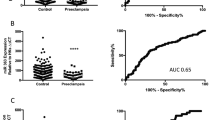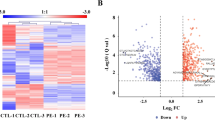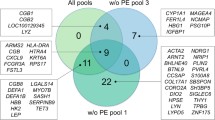Abstract
Preeclampsia is a multisystemic pregnancy-associated disease affecting about 3–7% of pregnancies worldwide and is still a principal cause of fetal and maternal morbidity and mortality. To identify potential markers, we have compared gene expression profiles from control and preeclamptic placental tissues taken at various age-matched gestational stages using complementary DNA microarray analysis. Besides previously identified preeclampsia-associated genes, novel differentially expressed transcripts were found. The soluble form of the disintegrin metalloprotease ADAM 12 (a disintegrin and metalloproteinase 12; meltrin-α) represented the most upregulated transcript. This was confirmed by in situ hybridization of sections of preeclamptic placentas and by serum protein analysis of preeclamptic pregnant women. Thus, ADAM 12 could serve as an early biomarker for preeclampsia that may be of predictive and/or functional significance.




Similar content being viewed by others
Abbreviations
- ADAM 12:
-
a disintegrin and metalloproteinase 12
- EBI3 :
-
Epstein–Barr virus-induced gene 3
- IGF:
-
insulin-like growth factor
- IGFBP:
-
insulin-like-growth-factor-binding protein
- LIM/LHX:
-
LIM homeobox domain protein
- MIFR-2:
-
metalloproteinase in the female reproductive tract 2
References
Lala PK, Chakraborty C (2003) Factors regulating trophoblast migration and invasiveness: possible derangements contributing to pre-eclampsia and fetal injury. Placenta 24:575–587
Lachmeijer AM, Dekker GA, Pals G, Aarnoudse JG, ten Kate LP, Arngrimsson R (2002) Searching for preeclampsia genes: the current position. Eur J Obstet Gynecol Reprod Biol 105:94–113
Luft FC (2000) The preeclampsia enigma and the renin–angiotensin system. J Mol Med 78:63–65
Luft FC (2003) Pieces of the preeclampsia puzzle. Nephrol Dial Transplant 18:2209–2210
Lipstein H, Lee CC, Crupi RS (2003) A current concept of eclampsia. Am J Emerg Med 21:223–226
Bilban M, Head S, Desoye G, Quaranta V (2000) DNA microarrays: a novel approach to investigate genomics in trophoblast invasion—a review. Placenta 21(Suppl A):S99–S105
Cross JC (2003) The genetics of pre-eclampsia: a feto-placental or maternal problem? Clin Genet 64:96–103
Dekker GA, Robillard PY (2005) Preeclampsia: a couple’s disease with maternal and fetal manifestations. Curr Pharm Des 11:699–710
Le Bouteiller P, Solier C, Proll J, Aguerre-Girr M, Fournel S, Lenfant F (1999) Placental HLA-G protein expression in vivo: where and what for? Hum Reprod Update 5:223–233
Pearson H (2002) Reproductive immunology: immunity’s pregnant pause. Nature 420:265–266
Page NM, Woods RJ, Gardiner SM, Lomthaisong K, Gladwell RT, Butlin DJ, Manyonda IT, Lowry PJ (2000) Excessive placental secretion of neurokinin B during the third trimester causes pre-eclampsia. Nature 405:797–800
Krauss T, Emons G, Kuhn W, Augustin HG (2002) Predictive value of routine circulating soluble endothelial cell adhesion molecule measurements during pregnancy. Clin Chem 48:1418–1425
Krauss T, Pauer HU, Augustin HG (2004) Prospective analysis of placenta growth factor (PlGF) concentrations in the plasma of women with normal pregnancy and pregnancies complicated by preeclampsia. Hypertens Pregnancy 23:101–111
Maynard SE, Venkatesha S, Thadhani R, Karumanchi SA (2005) Soluble Fms-like tyrosine kinase 1 and endothelial dysfunction in the pathogenesis of preeclampsia. Pediatr Res 57:1R–7R
Dechend R, Muller DN, Wallukat G, Homuth V, Krause M, Dudenhausen J, Luft FC (2005) Activating auto-antibodies against the AT1 receptor in preeclampsia. Autoimmun Rev 4:61–65
Dechend R, Gratze P, Wallukat G, Shagdarsuren E, Plehm R, Brasen JH, Fiebeler A, Schneider W, Caluwaerts S, Vercruysse L, Pijnenborg R, Luft FC, Muller DN (2005) Agonistic autoantibodies to the AT1 receptor in a transgenic rat model of preeclampsia. Hypertension 45:742–746
Goldman-Wohl D, Yagel S (2002) Regulation of trophoblast invasion: from normal implantation to pre-eclampsia. Mol Cell Endocrinol 187:233–238
Fritz B, Schubert F, Wrobel G, Schwaenen C, Wessendorf S, Nessling M, Korz C, Rieker RJ, Montgomery K, Kucherlapati R, Mechtersheimer G, Eils R, Joos S, Lichter P (2002) Microarray-based copy number and expression profiling in dedifferentiated and pleomorphic liposarcoma. Cancer Res 62:2993–2998
Wrobel G, Schlingemann J, Hummerich L, Kramer H, Lichter P, Hahn M (2003) Optimization of high-density cDNA-microarray protocols by ‘design of experiments’. Nucleic Acids Res 31:e67
Huber W, von Heydebreck A, Sultmann H, Poustka A, Vingron M (2002) Variance stabilization applied to microarray data calibration and to the quantification of differential expression. Bioinformatics 18(Suppl 1):S96–S104
Schorpp-Kistner M, Wang ZQ, Angel P, Wagner EF (1999) JunB is essential for mammalian placentation. EMBO J 18:934–948
Loechel F, Fox JW, Murphy G, Albrechtsen R, Wewer UM (2000) ADAM 12-S cleaves IGFBP-3 and IGFBP-5 and is inhibited by TIMP-3. Biochem Biophys Res Commun 278:511–515
Shi Z, Xu W, Loechel F, Wewer UM, Murphy LJ (2000) ADAM 12, a disintegrin metalloprotease, interacts with insulin-like growth factor-binding protein-3. J Biol Chem 275:18574–18580
Laigaard J, Sorensen T, Frohlich C, Pedersen BN, Christiansen M, Schiott K, Uldbjerg N, Albrechtsen R, Clausen HV, Ottesen B, Wewer UM (2003) ADAM12: a novel first-trimester maternal serum marker for Down syndrome. Prenat Diagn 23:1086–1091
Laigaard J, Christiansen M, Frohlich C, Pedersen BN, Ottesen B, Wewer UM (2005) The level of ADAM12-S in maternal serum is an early first-trimester marker of fetal trisomy 18. Prenat Diagn 25:45–46
Gilpin BJ, Loechel F, Mattei MG, Engvall E, Albrechtsen R, Wewer UM (1998) A novel, secreted form of human ADAM 12 (meltrin alpha) provokes myogenesis in vivo. J Biol Chem 273:157–166
Aronow BJ, Richardson BD, Handwerger S (2001) Microarray analysis of trophoblast differentiation: gene expression reprogramming in key gene function categories. Physiol Genomics 6:105–116
Tsoi SC, Cale JM, Bird IM, Kay HH (2003) cDNA microarray analysis of gene expression profiles in human placenta: up-regulation of the transcript encoding muscle subunit of glycogen phosphorylase in preeclampsia. J Soc Gynecol Investig 10:496–502
Pang ZJ, Xing FQ (2003) Comparative study on the expression of cytokine-receptor genes in normal and preeclamptic human placentas using DNA microarrays. J Perinat Med 31:153–162
Reimer T, Koczan D, Gerber B, Richter D, Thiesen HJ, Friese K (2002) Microarray analysis of differentially expressed genes in placental tissue of pre-eclampsia: up-regulation of obesity-related genes. Mol Hum Reprod 8:674–680
Pugh CW, Ratcliffe PJ (2003) Regulation of angiogenesis by hypoxia: role of the HIF system. Nat Med 9:677–684
Rajakumar A, Brandon HM, Daftary A, Ness R, Conrad KP (2004) Evidence for the functional activity of hypoxia-inducible transcription factors overexpressed in preeclamptic placentae. Placenta 25:763–769
Teramo KA, Hiilesmaa VK, Schwartz R, Clemons GK, Widness JA (2004) Amniotic fluid and cord plasma erythropoietin levels in pregnancies complicated by preeclampsia, pregnancy-induced hypertension and chronic hypertension. J Perinat Med 32:240–247
Devergne O, Coulomb-L’Hermine A, Capel F, Moussa M, Capron F (2001) Expression of Epstein–Barr virus-induced gene 3, an interleukin-12 p40-related molecule, throughout human pregnancy: involvement of syncytiotrophoblasts and extravillous trophoblasts. Am J Pathol 159:1763–1776
Blobel CP (2005) ADAMs: key components in EGFR signalling and development. Nat Rev Mol Cell Biol 6:32–43
Evans JP (2001) Fertilin beta and other ADAMs as integrin ligands: insights into cell adhesion and fertilization. BioEssays 23:628–639
Ito N, Nomura S, Iwase A, Ito T, Kikkawa F, Tsujimoto M, Ishiura S, Mizutani S (2004) ADAMs, a disintegrin and metalloproteinases, mediate shedding of oxytocinase. Biochem Biophys Res Commun 314:1008–1013
Leach RE, Romero R, Kim YM, Chaiworapongsa T, Kilburn B, Das SK, Dey SK, Johnson A, Qureshi F, Jacques S, Armant DR (2002) Pre-eclampsia and expression of heparin-binding EGF-like growth factor. Lancet 360:1215–1219
Asakura M, Kitakaze M, Takashima S, Liao Y, Ishikura F, Yoshinaka T, Ohmoto H, Node K, Yoshino K, Ishiguro H, Asanuma H, Sanada S, Matsumura Y, Takeda H, Beppu S, Tada M, Hori M, Higashiyama S (2002) Cardiac hypertrophy is inhibited by antagonism of ADAM12 processing of HB-EGF: metalloproteinase inhibitors as a new therapy. Nat Med 8:35–40
Kodama T, Ikeda E, Okada A, Ohtsuka T, Shimoda M, Shiomi T, Yoshida K, Nakada M, Ohuchi E, Okada Y (2004) ADAM12 is selectively overexpressed in human glioblastomas and is associated with glioblastoma cell proliferation and shedding of heparin-binding epidermal growth factor. Am J Pathol 165:1743–1753
Korff T, Krauss T, Augustin HG (2004) Three-dimensional spheroidal culture of cytotrophoblast cells mimics the phenotype and differentiation of cytotrophoblasts from normal and preeclamptic pregnancies. Exp Cell Res 297:415–423
Acknowledgements
We are grateful to Prof. U.M. Wewer for kind provision of the rb122 antibody, Dr. S. Stumm for filing of patient data, and the midwives on duty for their support. We thank S. Adams and T. Raubinger for excellent technical assistance and Drs. J. Hess, A. Kolbus, and H. Richter for helpful discussions and critical reading of the manuscript. This work was supported by the Training and Mobility of Researchers Programs of the European Economic Community and by the Deutsche Forschungsgemeinschaft (Scho 365/2-4).
Author information
Authors and Affiliations
Corresponding author
Additional information
Sabine Gack, Alexander Marmé, and Frederik Marmé contributed equally to this work
Electronic Supplementary Material
Rights and permissions
About this article
Cite this article
Gack, S., Marmé, A., Marmé, F. et al. Preeclampsia: increased expression of soluble ADAM 12. J Mol Med 83, 887–896 (2005). https://doi.org/10.1007/s00109-005-0714-9
Received:
Accepted:
Published:
Issue Date:
DOI: https://doi.org/10.1007/s00109-005-0714-9




